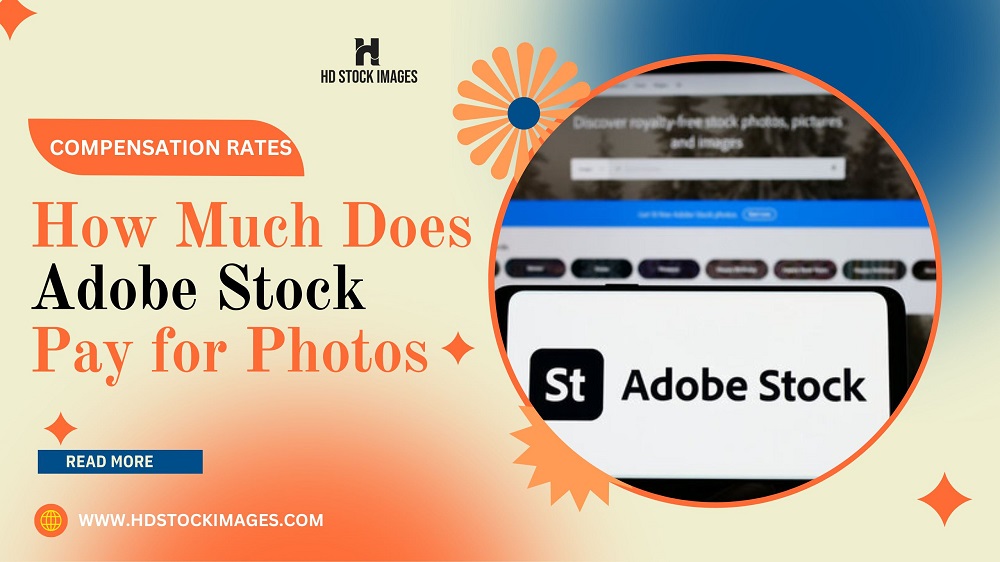1. Introduction to Adobe Stock and the Importance of Compensation Rates
In today's digital age, the demand for high-quality visual content has surged exponentially. As businesses, marketers, and creators seek captivating images to enhance their projects, stock photography platforms have become invaluable resources. One such platform that stands out prominently is Adobe Stock, a go-to hub for a vast array of photos, videos, illustrations, and more.However, beyond its role as a content repository, Adobe Stock offers an enticing opportunity for photographers and content creators to monetize their craft. This is where the concept of compensation rates comes into play—a crucial factor that often determines the financial rewards photographers can reap from their contributions. In this blog post, we delve into the intricate world of Adobe Stock's compensation rates, shedding light on how much photographers can potentially earn and the factors influencing these earnings.Also Read This: Printing Images on T-Shirts for DIY Fashion
2. Understanding Adobe Stock's Payment Model

Diverse Content, Unique Compensation
At its core, Adobe Stock is a versatile platform that caters to various forms of visual content—ranging from captivating photographs to captivating videos and illustrations. Understanding the payment model begins with recognizing the diversity of content that contributors can offer. Whether you're a photographer, videographer, or illustrator, Adobe Stock provides a platform for your creative expression.The Royalty-Based System
Adobe Stock operates on a royalty-based system, which means that contributors earn a percentage of the revenue generated from their content's sales. Each time a user purchases and downloads your content, you receive a portion of the revenue based on the license type and other contributing factors. This model incentivizes content creators to produce high-quality and marketable visuals, as their earnings are directly tied to their content's popularity.Contributor Levels and Tiers
Adobe Stock introduces a contributor level system that rewards engagement and performance. As you contribute and your content gains traction, you can progress through various contributor levels: beginner, bronze, silver, gold, and platinum. Each level comes with its own set of benefits, including potentially higher compensation rates, enhanced visibility, and access to exclusive opportunities. Your level is determined by the number of downloads and the quality of your content.Influential Factors in Compensation Rates
Several key factors play a role in determining the compensation rates you can expect from Adobe Stock:Type of Content: Different types of content have varying price points, influencing your potential earnings. While a photo might command one rate, a video or illustration could yield a different amount.Exclusive vs. Non-Exclusive Content: Adobe Stock rewards contributors who offer exclusive content, meaning the content is only available on their platform. This exclusivity can lead to higher compensation rates due to increased demand and rarity.Licensing Options: Adobe Stock offers standard and extended licenses. The license type chosen by the customer affects your compensation. Extended licenses, which grant additional usage rights, generally yield higher earnings.Geographic Location: Compensation rates can also be influenced by the geographic location of the customer. Adobe Stock adjusts prices to accommodate different markets, which can impact the revenue you receive.Intricately understanding these factors empowers contributors to strategically tailor their approach, optimize their earnings, and craft a roadmap toward higher compensation rates on Adobe Stock.As we've scratched the surface of Adobe Stock's payment model, let's dive deeper into the compensation rates specific to photographs—unveiling the mechanics of earnings and the implications of exclusivity in the world of stock photography.Also Read This: Understanding LinkedIn Easy Apply – A Step-by-Step Guide to Using LinkedIn’s Job Application Feature
3. Deep Dive into Compensation Rates for Photos

Earnings Calculation: The Inner Workings
For photographers contributing to Adobe Stock, understanding how their earnings are calculated is paramount. The compensation you receive per photo download is a percentage of the sale price. Adobe Stock operates with a dynamic pricing model, where the price of a photo depends on factors like resolution, license type, and market demand. Your earnings increase as you progress through contributor levels, with higher levels commanding a greater percentage of the sale price.Sample Compensation Scenarios
Beginner Level: At the beginner level, contributors earn a baseline percentage of the sale price. For instance, if a customer purchases a standard license for your photo at $10, you might earn around 25% as a beginner, resulting in $2.50 per download.Platinum Level: As you advance to the platinum level, your earnings per download increase due to the progressive contributor level system. At this stage, the same $10 sale might yield 60% in earnings, amounting to $6 per download.The Power of Exclusivity
One of the most compelling aspects of Adobe Stock's compensation structure is the potential for increased earnings through content exclusivity. By offering exclusive content, you set your creations apart from the competition, making them more desirable to customers. Consequently, Adobe Stock rewards exclusivity by offering a higher percentage of the sale price for exclusive content compared to non-exclusive content. This serves as an incentive for contributors to commit their best work exclusively to the platform, fostering a win-win scenario for both creators and customers.Exclusive Content Premium: Let's say a non-exclusive photo earns you 33% of the sale price, resulting in $3.30 from a $10 sale. However, if the same photo is offered exclusively, you might earn 60% of the sale price, translating to $6 for the same $10 sale.Exclusive Benefits: Beyond increased compensation rates, exclusive contributors often gain access to special promotions, enhanced visibility, and priority placement, further bolstering their earnings potential.By comprehending the mechanics of exclusivity and how it interacts with compensation rates, photographers can strategically position themselves to maximize their earnings and build a valuable portfolio on Adobe Stock.As we transition from dissecting compensation rates to practical strategies for optimizing earnings, it's essential to explore the proactive steps that photographers can take to enhance their presence, earnings, and impact on Adobe Stock.Also Read This: Curving Images: Tips and Tricks
4. Tips for Maximizing Earnings on Adobe Stock
Crafting High-Quality, In-Demand Content
Identify Popular Niches and Trends: Stay attuned to current visual trends and identify niches with high demand. Research what customers are searching for and tailor your content to match these preferences.Technical Excellence: Strive for technical excellence in your photography. Ensure your images are sharp, well-composed, and meet the platform's technical requirements.Consistency and Quantity of Uploads
Regular Uploads: Consistency is key. Regularly upload new content to keep your portfolio fresh and engaging for potential buyers.Diverse Portfolio: Diversify your portfolio by covering various subjects, styles, and themes. A diverse range of content can attract a wider audience and increase your chances of earning.Leveraging Licensing Options
Understand License Types: Familiarize yourself with the different license options—standard and extended. Tailor your pricing strategy based on the intended use of your content.Price Your Content Strategically: Price your photos competitively based on factors such as exclusivity, quality, and market demand. This can impact both your sales volume and earnings per sale.Engage with the Adobe Stock Community
Learn from Successful Contributors: Participate in Adobe Stock's contributor community to learn from experienced contributors. Seek advice, tips, and insights to refine your approach.Participate in Forums and Discussions: Engage in forums and discussions to share your knowledge and learn from others. Active participation can increase your visibility within the community.Stay Updated on Trends and Customer Preferences
Stay Informed: Keep yourself updated on evolving visual trends and changing customer preferences. Adapting your content to match these shifts can enhance your sales potential.Evolve and Adapt
Analyze Performance: Regularly review your sales data and analyze which types of content perform best. Use this information to refine your content strategy.Adapt to Feedback: Pay attention to customer feedback and adapt your content based on their preferences. Positive customer experiences can lead to increased sales and higher ratings.Maximizing earnings on Adobe Stock requires a combination of creativity, strategic thinking, and continuous adaptation. By employing these tips, you can create a dynamic approach that positions you for success and ensures a steady flow of income from your photography endeavors.As we turn our attention to real insights from photographers who've walked the Adobe Stock journey, we'll gain invaluable perspectives that shed light on the platform's potential and the ways to harness it effectively.Adobe Stock vs. Shutterstock Earnings, all I'm saying is that one platform seems to be a lot more fair with their slip...granted royalties aren't what they should be on either platform...once just clearly is better. pic.twitter.com/a6WAwyBbb3
— Dominik Skorynko 🎥📸 (@DominikSkorynko) May 2, 2022
Also Read This: How to Add a White Outline to an Image for Enhanced Visibility
5. Real Insights: Photographer Interviews
| Interviewee | Experience Level | Key Insights |
| Sarah Martinez | Platinum | - Consistency is vital; regular uploads maintain visibility. |
| - Developing a niche can attract a dedicated audience. | ||
| - Exclusive content yields higher earnings and perks. | ||
| - Engaging with the community fosters growth and learning. | ||
| - Patience is crucial; success builds over time. | ||
| Alex Wong | Gold | - Diversifying content caters to a broader clientele. |
| - Strategic pricing attracts both frequent and occasional buyers. | ||
| - Participating in Adobe Stock challenges boosts visibility. | ||
| - Collaboration with fellow contributors leads to new ideas. | ||
| - Balancing creative passion with market demands ensures sales. | ||
| Mia Johnson | Silver | - Research customer needs and tailor content to fill gaps. |
| - Updating older content keeps it relevant and appealing. | ||
| - Honing post-processing skills elevates photo quality. | ||
| - Networking with other photographers expands knowledge. | ||
| - Consistent learning and improvement are key to growth. |

 admin
admin








